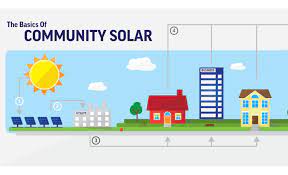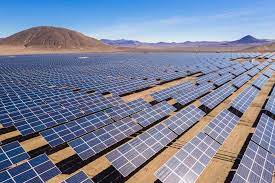What is Community Solar?
The U.S. Department of Energy defines community solar as any solar project or purchasing program, within a geographic area, in which the benefits of a solar project flow to multiple customers such as individuals, businesses, nonprofits, and other groups. In most cases, customers are benefitting from energy generated by solar panels at an off-site array.
Community solar customers can either buy or lease a portion of the solar panels in the array, and they typically receive an electric bill credit for electricity generated by their share of the community solar system—similar to someone who has rooftop panels installed on their home. Community solar can be a great option for people who are unable to install solar panels on their roofs because they don’t own their homes, have insufficient solar resources or roof conditions to support a rooftop PV system due to shading, roof size, or other factors, or for financial/other reasons.
Community solar is rapidly growing across the country. The National Renewable Energy Laboratory tracks installation data on community solar across the country.
How Does Community Solar Work?
Community solar business models vary depending where a subscriber lives. As of 2020, about a third of states have enabling policies for community solar. That means they have passed legislation that created a third-party market for community solar requiring project developers and utilities (typically the larger, investor owned utilities) to follow certain regulations in order to enroll customers and develop community solar installations. Community solar programs that exist outside of those states are developed and managed by the local utility (typically the smaller municipal or cooperative utilities).
In addition to the more common off-site model of community solar, there is also an on-site multifamily community solar model where occupants of apartment and condominium buildings each benefit from the energy produced from the rooftop array.
When it comes to subscribing to community solar programs, there’s no one-size-fits-all approach because of varying laws and regulations. Each subscriber organization presents the economic opportunity differently to its subscribers. In states with enabling policies, most community solar subscribers receive two bills—one from the community solar program for their portion of solar energy, and the other from the utility for the portion of traditionally generated electricity they’ve consumed. Some states are looking to simplify the process and combine the bills.
What are the Customer Benefits of Community Solar?
Community solar allows everyone to benefit from solar energy, even if they can’t put panels on a rooftop. In areas where solar power is less expensive than traditionally generated electricity, consumers can save money on their monthly bills. If subscribers move to a new home within the same utility service territory or county, they can typically continue to benefit from their community solar share. Programs may also have options for selling or donating subscriptions.
What are the Utility Benefits of Community Solar?
Because most community solar arrays are located off-site, utilities can strategically locate the systems in areas of the grid that can benefit the most. Additionally, developing community solar arrays enables utilities to improve their relationships with customers and increase engagement.
How is the U.S. Department of Energy Solar Energy Technologies Office (SETO) Improving Community Solar?
SETO is advancing community solar through the National Community Solar Partnership, which is a coalition of community solar stakeholders working to expand access to affordable community solar to every American household by 2025. Partners leverage peer networks and technical assistance resources to set goals and work to overcome persistent barriers to expanding community solar access to underserved communities.
SETO also funded the Solar in Your Community Challenge, a prize competition that worked to expand solar electricity access to all Americans, especially underserved segments such as low- and moderate-income households. The challenge supported teams across the country to develop projects or programs that expand solar access to underserved groups, while proving that these business models can be widely replicated and adopted by similar groups. Learn more about SETO’s work to increase solar access and affordability.
Continua a leggere

Subscribe to our newsletter
Promotions, new products and sales. Directly to your inbox.


